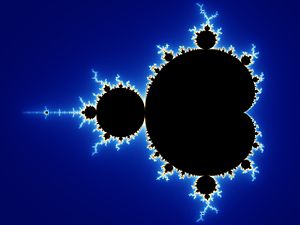For the 2009 recording by Skyfire, see
Fractal (EP).


The
Mandelbrot set is a famous example of a
fractal
A
fractal is generally "a rough or fragmented
geometric shape that can be split into parts, each of which is (at least approximately) a reduced-size copy of the whole,"
[1] a property called
self-similarity. Roots of mathematical interest on fractals can be traced back to the late 19th Century, the term however was coined by
Benoît Mandelbrot in 1975 and was derived from the
Latin fractus meaning "broken" or "fractured." A mathematical fractal is based on an
equation that undergoes
iteration, a form of
feedback based on
recursion.
[2]
A fractal often has the following features:
[3]Because they appear similar at all levels of magnification, fractals are often considered to be infinitely complex (in informal terms). Natural objects that approximate fractals to a degree include clouds, mountain ranges, lightning bolts, coastlines, snow flakes, various vegetables (cauliflower and broccoli), and animal coloration patterns. However, not all self-similar objects are fractals—for example, the
real line (a straight
Euclidean line) is formally self-similar but fails to have other fractal characteristics; for instance, it is regular enough to be described in Euclidean terms.
Images of fractals can be created using
fractal-generating software. Images produced by such software are normally referred to as being fractals even if they do not have the above characteristics, as it is possible to zoom into a region of the image that does not exhibit any fractal properties.
6]